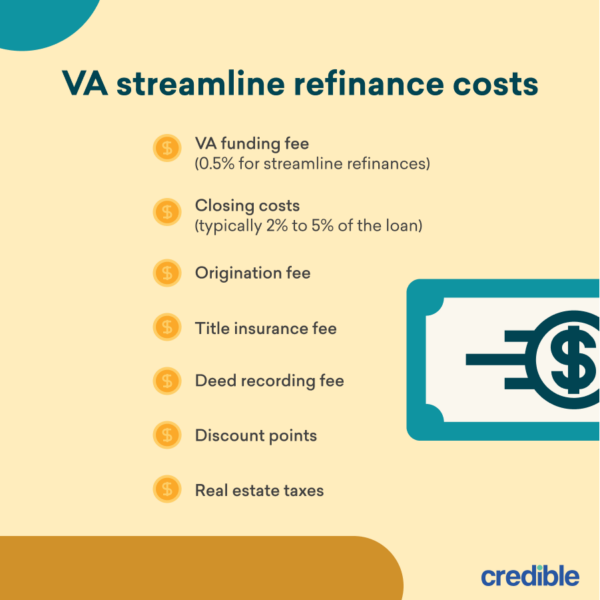If you’re a veteran with a VA home loan, there’s a simple way to refinance that could save you money.
A VA streamline refinance — or VA interest rate reduction refinance loan (IRRRL) — may be able to lower your interest rate, shorten your mortgage term, or shrink your monthly payment, often with no appraisal or credit underwriting.
What is a VA streamline refinance (VA IRRRL)?
If you’re an active-duty military service member, veteran, or surviving spouse with a VA mortgage, you might be thinking about refinancing to lower the interest rate on your current home loan.
An IRRRL can help you accomplish this by replacing your existing VA loan with a new one that has a different interest rate and monthly payment, and possibly a different term.
What makes this refinance “streamlined” is that it typically requires fewer steps and less paperwork. For instance, the VA doesn’t require an appraisal or credit underwriting for this loan, which means you’ll usually close faster than someone doing a conventional refinance.
Learn More: How Soon You Can Refinance
VA streamline refinance rates
Veterans United, a major originator of VA loans, says that the interest rates on VA loans tend to be 0.5% to 1.0% lower than the interest rates on conventional mortgages.
Good to know: While somewhat helpful, general figures like these won’t tell you what type of mortgage you’ll get the best rate on. Your personalized rate depends on your financial situation and what’s happening in the mortgage market when you apply.
Rates also vary by mortgage lender, loan term, and how much home equity you have. For example, if you have at least 20% equity and can pass underwriting and an appraisal, you might find a better interest rate and lower APR by refinancing into a conventional loan, even if you qualify for an IRRRL.
Getting pre-approved with multiple lenders will give you the best idea of what rates you qualify for. It’ll also allow you to compare loan costs and get a taste of the lender’s customer service before committing to the mortgage approval process.
VA streamline refinance loan benefits
A VA streamline refinance has several appealing advantages:
- Competitive rates: VA loan rates tend to be similar to or slightly less than conventional loan rates.
- No private mortgage insurance: Even with less than 20% equity, there’s no PMI or equivalent for VA loans like there is for conventional loans and FHA loans.
- No appraisal: A no-appraisal refinance will save you a few hundred dollars in upfront costs. It also means you may be able to refinance a home that’s lost value.
- Less documentation: A VA streamline refinance doesn’t require underwriting, so you may be able to forgo gathering bank statements and tax returns for lenders.
- Closing cost financing: Avoid out-of-pocket costs by rolling closing costs into your new loan.
- Quick closing: No underwriting and no appraisal means it likely won’t take as long to refinance your home.
- No occupancy requirement: You can do a streamline refinance on a home you no longer occupy as your primary residence.
- Catch up if you’ve fallen behind: If your VA loan is past due, you may be able to use an IRRRL with credit underwriting to catch up on overdue payments, pay off late fees, and get into a more affordable loan that will stabilize your situation.
Good to know: The VA’s lending guidelines don’t require credit underwriting or an appraisal for an IRRRL, but they also don’t forbid it. Lenders may still want to check your credit or order an appraisal, and if they do, they’re allowed to charge you for those costs.
Drawbacks of VA streamline refinance loans
Even though a VA streamline refinance is meant to be money-saving and efficient, you should understand how its drawbacks might affect you:
- Funding fee: You’ll pay a funding fee each time you get a VA loan. The fee is 0.5% of the loan amount for an IRRRL.
- Existing VA loan required: If you have a conventional loan or FHA loan, you’re not eligible for an IRRRL. However, you may qualify for a VA cash-out refinance.
- Closing costs: Expect to pay fees for loan origination, title insurance, and local government requirements.
- Restarting your loan term: Many borrowers choose the same loan term when they refinance. If you currently have a 30-year loan that you’ve been paying for four years, you’ll be mortgage-free in 26 years. But if you refinance into a new 30-year loan, you’ll have to start over.
- No cash out: Borrowers are not allowed to cash out any equity with an IRRRL unless the money is a reimbursement for energy-efficient home improvements completed within 90 days of closing and costing no more than $6,000.
- Waiting period: You’re not eligible for an IRRRL until you’ve had your existing VA loan for 210 days and made six consecutive monthly payments.
Tip: You can avoid restarting your loan term by refinancing into a shorter term or prepaying principal on your new mortgage. If you refinance into a shorter term and your new payment is at least 20% higher than your existing payment, you’ll have to go through underwriting.
Compare Your Options: 3 Ways to Refinance a VA Loan
VA streamline refinance eligibility guidelines
Qualifying for a VA streamline refinance can be easier than qualifying for other refinance loans. Here are the key criteria and a brief explanation of each one:
VA IRRRL costs
The closing costs for a VA streamline refinance are similar to the closing costs for other VA loans. However, you likely won’t have to pay for an appraisal, which will save you a few hundred dollars. Here are some of the closing costs often associated with a VA IRRRL:

Closing costs typically range from 2% to 5% of the loan amount. Most borrowers pay an origination fee, title insurance fee, and deed recording fee. You may also owe local taxes, which are inexpensive in some areas and quite costly in others. And some borrowers choose to prepay mortgage interest through points in exchange for a lower interest rate.
A closing cost unique to VA loans is the VA funding fee: on an IRRRL, the fee is 0.5% or $500 for every $100,000 borrowed. You may be exempt if you’re receiving payments for a service-connected disability or you’ve earned a Purple Heart.
Rolling closing costs into your VA IRRRL
An IRRRL allows you to roll your closing costs into the loan. You might benefit from this option if
you stand to save a lot from refinancing but don’t have cash on hand. It can also be a smart move if you’re planning to sell your home the next time you get a permanent change of station (PCS) order. It probably doesn’t make sense to pay a lot upfront for a loan you’ll have short term.
On a 30-year mortgage, here’s how much more you would pay over the life of the loan by rolling $12,000 in closing costs (4% of $300,000) into the loan instead of paying them upfront.
While inflation is normally seen as a bad thing, it can be good for mortgage debtors with fixed interest rates. As years pass, even modest price and income inflation can make your mortgage debt feel less expensive.
In other words, while an extra $6,300 may sound like a lot today, it’ll feel like less and less each year due to inflation. Still, the higher your interest rate, the less you may want to borrow.
How to apply for a VA IRRRL
If you apply for a VA IRRRL, the process will look something like this:
- Identify reputable lenders that offer a VA streamline refinance.
- Submit a pre-approval application online or by phone with at least three lenders.
- Compare your Loan Estimate from each company, looking for the best terms for your situation.
- Decide how many points to pay, if any, to lower your rate.
- When you’re happy with current interest rates, lock your rate.
- Submit any supporting documents your lender asks for. Your lender will usually be able to obtain your VA loan certificate of eligibility (COE) for you.
- Sign the paperwork to close on your loan.
Is a VA streamline refinance loan right for you?
Refinancing an existing home loan into a new loan may be a good idea if you’ll be able to lower your interest rate by at least one percentage point. It also makes sense if you expect to keep your new loan long enough to break even on closing costs.
A VA streamline refinance in particular may be right for you if you’ve lost your job, your credit score has dropped, your income has decreased, or your home’s value has declined. Since lenders aren’t required to order an appraisal or perform credit underwriting for an IRRRL, this type of refinance could help you keep your home if times have gotten tough.
Tip: If you’re struggling to pay your mortgage, contact the Department of Veterans Affairs. They will assign a loan technician to help you.
If you plan to move soon or can’t lower your rate, refinancing may not help you. And if you have at least 20% equity, good credit, and a steady income, it’s worth comparing quotes for both an IRRRL and a conventional refinance.

